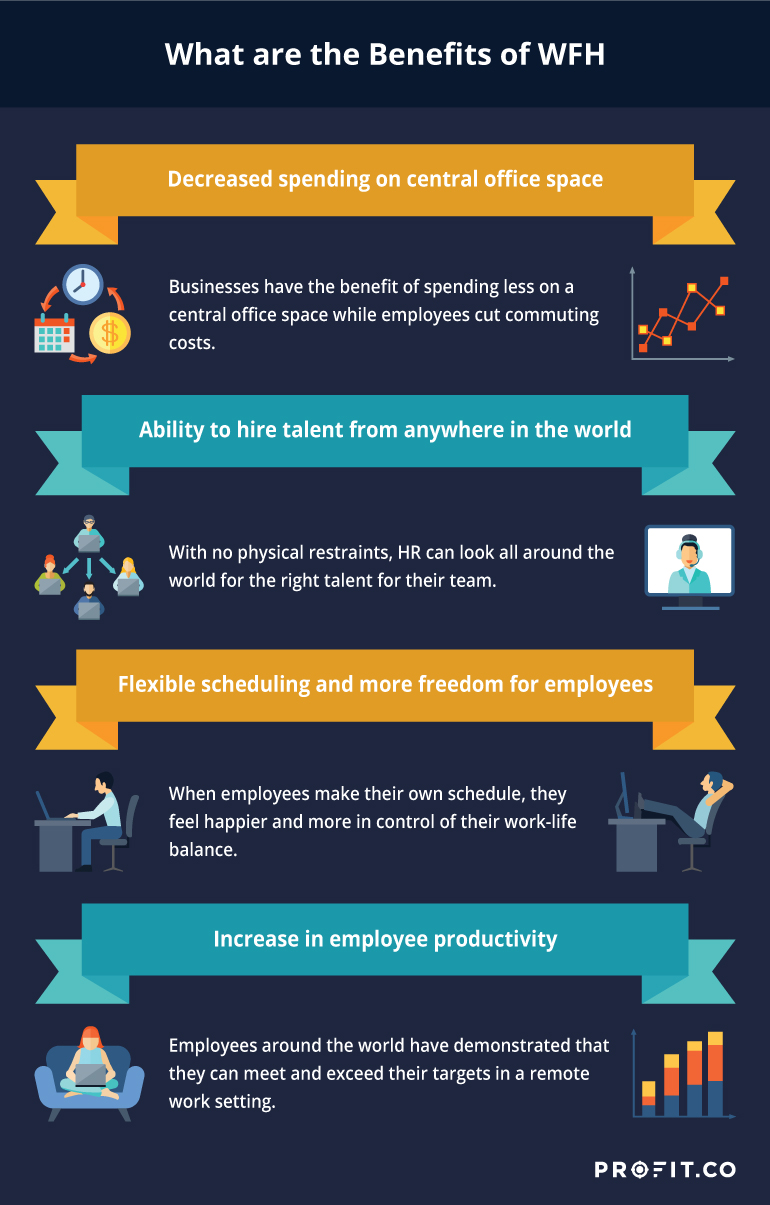What does WFH mean?
WFH is the abbreviation for Work From Home. It means an employee is working from a place of residence, an apartment or house, rather than working from the office. Many companies have a WFH policy; it allows their employees to work from home full-time or as a hybrid model where they occasionally work from home and occasionally from their office. However, WFH has become the norm over the past two years with the pandemic, where almost every office everywhere was required to follow the WFH or remote work policy due to health concerns.
As we’ve moved to virtual work, we haven’t just coped, we’ve actually thrived. We are more focused on the things that have the greatest impact for our customers, associates and the business.
Usually, employees have a dedicated work laptop or PC, or applications on their personal computer that are specifically used to collaborate and communicate with their team members and office co-workers.
What are the challenges of WFH for employers?
There are many business leaders singing the praises of the remote work model– however, it’s not without its challenges. There are two key problem areas when it comes to the WFH model: collaborating remotely, and managing employees in different locations and time zones.
Collaborating remotely
Collaborating remotely is a big challenge for employees as employees do not work in-person on site from the same physical office space. Now, employees must rely on task management tools to stay in touch with their coworkers and ensure that nothing falls through the cracks.
Carefully recording everything on a central work database is a big jump from being able to walk over to a coworker’s desk and ask a question or relay information. This has created a challenge among managers and leaders who have had to swiftly train their team in a new style of working and collaborating.
Employees from different locations and time zones
While working remotely comes with the advantage of recruiting talent from anywhere, it also has the downside of them being from different time zones; which means that if they have to collaborate or be part of the same meeting, it would mean working at odd times for some of them. And therefore, finding the time to schedule meetings that work for all team members across time zones can be challenging.
Collaborating with team members, finding the right time to schedule weekly team meetings or even 1:1 meetings can become incredibly difficult when employees are spread out across multiple states and countries.
What are the challenges of WFH for employees?
WFH has brought some challenges for employees themselves as well. The two main problem areas that have become apparent in the last two years of remote work are prolonged periods of work and a feeling of isolation among employees.
Prolonged periods of work
When employees work from home, they do not have scheduled breaks, informal breaks with office co-workers, commutes, or any formal structure to their day at all. The benefit of a routine is that it ensures that employees are taking ample time to rest and recharge. This means that employees can end up working for prolonged periods of time. While this might initially result in increased remote performance and higher productivity, in the long-run, this can cause employee burnout.
Working from home also means having to balance work life and personal life under the same roof. With no physical boundaries to demarcate work and personal life, it can be exhausting and stressful with constantly having to manage both.
A feeling of isolation
Sharing the same physical office space automatically fosters informal social interactions with co-workers. These informal interactions have multiple benefits; they build camaraderie, make working with each other easier, and encourage the exchange of ideas even if they are not part of the same team. Working from home cuts out all these office space interactions and can leave employees with a sense of loneliness.
A lack of closeness and interaction can lead to plummeting employee engagement, which negatively affects productivity, job satisfaction, and employee retention.
The best way to overcome remote work challenges is to use powerful software that makes collaborating with your team and staying up to date on business health simple. Profit.co enables business leaders to transparently track important goals and projects with a suite of customizable business management tools. You can try Profit.co completely free for thirty days here!
The benefits of WFH – Work from Home
- Decreased spending on central office space
- Ability to hire talent from anywhere in the world
- Flexible schedule and more freedom
- Increase in productivity
Decreased spending on central office space
When there are more employees working remotely, there’s less office space required, which means reducing costs. Limited central office space also means that employees don’t have to commute to work everyday, meaning they spend less on gas or public transportation passes, business clothing, and they can even move farther away from their company’s main office if it is in an expensive location or city.
Ability to hire talent from anywhere in the world
When there is no physical office space, organizations can hire talent from all over the world since there is no limitation to location. As long as the person has the right skills and fits the job profile, HR can hire them without having to worry about whether they can relocate closer to the company. In this sense, WFH makes talent and people management easier.
Flexible schedule and more freedom
When employees work from home, they get the freedom and flexibility to create their own schedule. They can pick a time that works for them best. It helps them focus on their work without having to worry about commuting to work, or any other distractions at work.
Increase in productivity
When employees can create their own work schedule, they are more productive. If they have their own spot or space at home where they can work, it creates a positive experience and is more conducive for work. Moreover, with no excessive breaks or disruptions from coworkers, work from home employees can end up being more productive than their in-office counterparts.

Work from home tools to make it a success
As you can see, work from home has its share of benefits and challenges just like most things in life. However, given that remote working has become not only a norm, but an expectation, leaders need to find ways to ensure that WFH is a success in their organization. Below, we’ve listed out a few tools to make WFH a success:
- Tools to collaborate and for communication
- Project management tools
- Cloud storage tools
- Tools to screen share and record
- Digital workplace platforms
Tools to collaborate and for communication
To make sure work from home works for everyone, there needs to be effective communication tools that employees can use so that productivity doesn’t stall out in a remote setting. Instant messaging, video calls, and phone calls are some of the communication tools that can come in handy while working with team members who are also remote.
Project management tools
The right project management tool ensures that everyone is on the same page even when they don’t share the same physical space. A central platform that transparently shows project progress can help keep everyone aligned with whatever tasks they are working on.
Cloud storage tools
Every team member must have access to the latest version of the files that they are collectively working on, from any geographical location. This makes a great cloud storage tool like Google Drive or Dropbox absolutely essential.
Tools to screen share and record
Tools that help you screen share and record calls are just as important as standard communication tools when it comes to remote work. When a team member can screen share, their fellow team members can see in real time what they are referring to while having a meeting or discussion, which takes ambiguity out of the equation. Screen sharing and recording calls can help you have a more productive discussion, giving everyone context and allowing them to revisit conversations if they’re confused or if they miss a meeting.
Have a digital workplace platform
A digital workplace offers employees a platform with a suite of tools to help them manage all their tasks and responsibilities. This platform usually has a cloud storage tool, a communication tool, time management and timesheets trackers, and other project management features that help manage every aspect of work. This eliminates the need for the employees to have to spend time trying to manage their responsibilities with post-it notes or written planners, and makes it easier to collaborate outside of an office.
Profit.co offers an all-in-one software solution that combines OKR, performance, task, strategy management, as well as employee engagement on one integrated platform. Profit.co is the ultimate tool for managing a business– whether you’re on-site, hybrid model, or completely WFH. To find out more about how Profit.co can revolutionize your approach to remote working, book a free demo with our experts!
In Conclusion
Work from home is the new norm. As alien a concept as it might have appeared two years ago, technology, organizations, and employees have evolved and adapted dramatically during the pandemic. When an organization truly cares for its employees, it ensures that it has all the right tools and resources to make work from home a success for the company as well as its employees.

